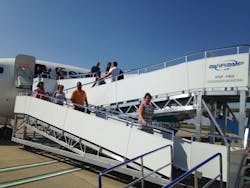Aviramp Caters To The PRM Market With A Ramp Fit For All Passengers
A UK company manufacturing an interesting take on an aircraft boarding ramp for remote stands secured a major order last summer from Dallas Fort Worth International Airport. An order for seven so-called Aviramps worth $660,000 was secured by Ra’alloy Ramps.
Although designed in particular to help passengers with reduced mobility get on and off aircraft, the Aviramp allows all passenger’s to board together.
Traditionally, people with impaired mobility have had to be carried up and down the air stairs by handlers or taken away from other passengers and boarded on a modified truck.
One key to the Aviramp design is the gentle 8-degree slope that makes aircraft access easy for those pushing a wheelchair and for PRM.
Aviramp features automatic braking systems, speed control, a spring-loaded docking plate and since they are made of aluminum as well as steel to keep the weight down the portable ramp can be controlled by just one operator.
Commercial airline pilot and Aviramp co-developer Adam Corfield previously worked for the low cost airline industry and he knows first-hand that a common delay on making turns in such cases was waiting for specialized equipment to help disabled passengers.
“With Aviramp costing roughly 18 percent of a traditional high lift, the airport or ground service provider gains the ability to release capital investment from sales plus eliminating a huge maintenance cost, " Corfield explains. "In turn, this provides the airport and GSP an opportunity to operate with a more modern and cost effective strategy."
The buyers at DFW initially bought two different models, which service the Airbus A319 and Boeing 737, at the beginning of last year for evaluation, before following up with two more, smaller, models which service smaller regional jets. Corfield said he was surprised when another order came in, including for an international model which is to be used on aircraft such as the Airbus A380.
GETTING STARTED
Ra’alloy Ramps started in 1994 by making ramps for cars and trucks all designed for easing disabled access and efficiently loading and unloading material.
It became involved in improving access in the aviation industry by chance after a Norwegian airport spotted its website. Eventually, the firm was contacted by Oslo Airport, which was looking for a better way to help passengers with limited mobility on and off aircraft.
Closer to its home base of Shropshire, UK, Ra'alloy began designing and testing ramps with UK-based airline Easyjet. The airline's ground operations staff had researched this idea in the past, but were unable to find any company willing to develop such a passenger boarding ramp.
The company’s first trails in 2011, quickly delivered results:
- Passengers boarded and disembarked quicker by up to 9 minutes on a full A319 aircraft.
- Disabled travelers and passengers with reduced mobility were happy to board with all other passengers.
- Wheelchairs could be pushed up the ramp with one attendant due to gentle slopes.
The equipment also had additional benefits that went behind the PRM market:
- Children could board safely without the fear of them falling down stairs.
- General passengers preferred walking on the ramp instead of climbing and descending stairs, particularly with luggage.
Since the initial trials many airports and airlines are operating Aviramp aircraft boarding jet bridges globally and developing the step free airport concept.
Current customers include ground service provider Swissport in Japan, airports in Japan, Kuwait, Italy, France and the US and carriers including Qatar Airways, Jetstar and Qantas (which has just taken five units of the hand-pulled Aviramp Lite model).
Aviramp‘s Managing Director Graham Corfield comments: “Aviramp is at its central stage of global expansion, Aviramp is well-positioned to achieve its global strategic objectives with a strong product and a clear mission statement for the future. We plan to return investment into the business which in turn is great news for our operations. We have already had to expand our operations by 400 percent and move to a larger manufacturing plant."
Passenger Boarding Bridge Market To Reach $7.5 Billion By 2020, Forecast Says
The global market for airport passenger boarding bridges will grow to $7.5 billion by 2020, with a combined annual growth rate (CAGR) of 4.85 percent, predict analysts at market researcher Markets and Markets in Dallas.
Driving the passenger boarding bridge market is increasing air travel demand and growing air passenger traffic, the analysts say. Over the last few decades the use of automated passenger boarding bridges witnessed a drastic increase as airport authorities sought to reduce passenger turnaround time.
Markets and Markets analysts outline their global boarding bridge forecast in the airport infrastructure report Passenger Boarding Bridge Market - Global Forecast to 2020, which has 55 market data tables, 54 figures, and 248 pages.
"Air travel used to be an expensive affair, often used by high income earners, executive-class business professionals, and political leaders to travel to distant places," the report says. "Only few players had been providing air transport facilities, as passenger traffic was comparatively lesser. Globalization is considered to be a major and the most important factor that has built and expanded the aviation industry as it stands today."
Increasing air travel demand and growing air passenger traffic is considered as a major aspect leading to the transformation of airports. Over the last few decades, usage of automated passenger boarding bridges witnessed a drastic increase. The airport authorities made significant investments, in order to integrate automated PBBs, which would help in reducing the passenger turnaround time.
The research breaks down the study by the following factors:
- PBB type (Apron Drive, Radial, Fixed Pedestal, Elevated “T,” Standard Drive, Mobile (Telescopic), Noseloader, and Dual Boarding).
- Airport (Class A, Class B, and Class C).
- Geography, including major regions and countries, which is broken down into the following: North America (U.S. and Canada); Europe (The UK, Germany, and Russia); Asia-Pacific (China, Japan, and Australia); The Middle East (Qatar, Saudi Arabia, and UAE); and Latin America and Africa
Asia-Pacific is expected to register a higher CAGR, led by China and the total market for passenger boarding bridges in this specific region is projected to $7.5 million by 2020.
"Large scale airport modernization and development program implemented by the concerned authorities in this specific region is the major factor that will drive the demand of passenger boarding bridges, furthermore fuelling the growth of PBB market," according to the report.
The report also includes profiles on the major players in PBB market:
- JBT Aerotech
- MHI-TES
- ThyssenKrupp
- Adelte Group
- CIMC Group
- FMT gate support systems AB
- Hubner Gmbh & Co.
- Airport Equipment Ltd.
- Shinmaywa Industries Ltd.
- Sovam A.S.
If you are interested in purchasing a copy of the report, log to www.marketsandmarkets.com or email to [email protected] or in the United States, call 888-600-6441.
Aviramp Benefits
Aviramp brings all of the benefits of finger-style terminal jet bridges to remote stands.The design of Aviramp compresses 65-plus feet of ramp at an average of approximately 8 degrees of slope, depending on model.
Larger models can be fitted with optional extras such as lighting and roofing.
For the airline, Aviramp offers a new way to provide on-time turns. The equipment removes any reliance on secondary high lift equipment for disabled passengers since all passengers can board and disembark through one point of access.
- 10 year structural guarantee.
- Simple hydraulic systems powered by a small 5Kw diesel engine for single ground crew operation.
- Ultra low maintenance
- Fast track crew stairs can also be opened in an emergency offering passengers two points of escape.
- Patented double switchback ramp design allows gentle 7.5- 8-degree slopes. where single ground crew can easily push wheelchairs.
- Galvanized steel chassis with lighter weight aluminum upper section gives low center of gravity for immense stability in high winds.
- Solid handrail panels prevents children from falling through the side.
- No medical lift required for disabled passengers.
- Use to load catering bars.
- No falls from steep stairs particularly for parents carrying children.
- Airline documented passenger boarding and disembarking trials show time is decreased by as much as one third.
- A fraction of the cost of medical lifts.

